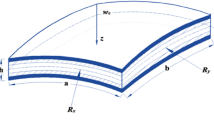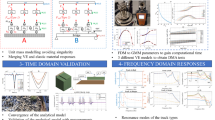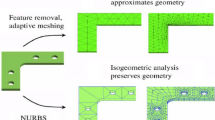Abstract
Modern 3D modelling software reduces the need for a large number of prototypes, means fewer product-development cycles and lower costs (time/cost), as well as improving the quality of furniture designs. However, the mechanical testing of final products is still required in order to confirm the simulation results. In this study the theoretical behaviors of different plywood seating shells (using the SolidWorks® FEM simulation software) were compared with the real results obtained using tests to measure the deformation of the backrest. The deviations of the actual deformation from the simulation were significant for the different shells and increased with loading above the elastic deformation limit of the material. It was concluded that the SolidWorks® simulation software could be effectively used in the calculation of the component displacements, strains, and stresses of seat designs subject to internal and external loads.








Similar content being viewed by others
References
Brinson HF, Brinson LC (2015) Chap. 2: stress and strain analysis and measurement. Polymer engineering science and viscoelasticity. Springer, New York, pp 15–55
Cai L, Wang F (1993) Influence of the stiffness of corner joint on case furniture deflection. Holz Roh Werkst 51:406–408
Colakoglu MH, Apay AC (2012) Finite element analysis of wooden chair strength in free drop. Int J Phys Sci 7:1105–1114
Dinwoodie JM (2000) Timber its nature and behaviour. E & FN Spon, London
EN 1728 (2002) Furniture—seating—test methods for the determination of strength and durability. European Committee for Standardization, Brussel
EN 14272 (2011) Plywood—calculation method for some mechanical properties
EN 15373 (2007) Furniture—strength, durability and safety—requirements for non-domestic seating. European Committee for Standardization, Brussel
EN 310 (1993) Wood-based panels—determination of modulus of elasticity in bending and of bending strength. European Committee for Standardization, Brussel
EN 1022 (2006) Domestic furniture—seating—determination of stability
Eckelman CA (1966) A look at strength design of furniture. For Prod J 3(16):21–24
Eckelman CA, Sudarth SK (1969) Analysis and design of furniture frames. Wood Sci Technol 3:239–255
Efe H, Erdil YZ, Kasal A (2008) Optimisation of furniture systems using finite elements in furniture design. In: Proceeding of the 1st advanced technologies symposium, 24–25 April, Ankara, pp 315–323
Erdil YZ, Haviarova E., Eckelman CA (2004) Product engineering and performance testing in relation to strength design of furniture. Wood Fiber Sci 36(3):411–416
Erdil YZ (2002) Integrated product engineering and performance testing of furniture. PhD Thesis, Purdue University, West Lafayette, Indiana
Gustafsson SI (1995) Furniture design by use of the finite element method. Holz Roh Werkst 53:257–260
Gustafsson SI (1996a) Stability problems in optimised chairs? Wood Sci Technol 30:339–345
Gustafsson SI (1996b) Finite element modelling versus reality for birch chairs. Holz Roh Werkst 54:355–359
Gustafsson SI (1997) Optimising ash wood chairs. Wood Sci Technol 31:291–301
Gustafsson SI (2010) The strength properties of swedish oak and beech. Drewno Pr Nauk Donies Komunik 53(183):67–83
Kasal A (2006) Determination of the strength of various sofa frames with finite element analysis. Gazi Univ J Sci 19:191–203
Kasal A, Zhang J, Yuksel M, Erdil YZ (2008) Effects of screw sizes on load bearing capacity and stiffness of five-sided furniture cases constructed of particleboard and medium density fiberboard objectives. For Prod J 58:25–32
Kljak J, Brezović M, Jambreković V (2006) Plywood stress optimisation using the finite element method. Wood Res 51:1–10
Koc KH, Kizilkaya K, Erdinler ES, Korkut DS (2011) The use of finite element method in the furniture industry. Afr J Bus Manage 5:855–865
Mackerle J (2005) Finite element analyses in wood research: a bibliography. Wood Sci Technol 39:579–600
Merhar M, Bučar B (2012) Cutting force variability as a consequence of exchangeable cleavage fracture and compressive breakdown of wood tissue. Wood Sci Technol 46:965–977
Merhar M, Gornik Bučar D, Bučar B (2013) Mode I critical stress intensity factor of beech wood (Fagus Sylvatica) in a TL configuration: a comparison of different methods. Drvna Industrija 64(3):221–229
Mirianon F, Fortino S, Toratti T (2008) A method to model wood by using ABAQUS finite element software: Part 1. Constitutive model and computational details, VTT Technical Research Centre of Finland, Kemistintie, Finland, p 58
Schneider S, Welsch J (2014) Seat shell for seating furniture. US20140077573 A1. US Patent office, Alexandria, Virginia
Smardzewski J (1998) Numerical analysis of furniture constructions. Wood Sci Technol 32:273–286
Smardzewski J (2002) Strength of profile-adhesive joints. Wood Sci Technol 36:173–183
Smardzewski J, Lewandowski W, Imirzi HO (2014) Elasticity modulus of cabinet furniture joints. Mater Design 60:260–266
SolidWorks® 2012 (2012) SolidWorks Simulation. SolidWorks, Waltham, Massachusetts, USA, p 494
SolidWorks® 2014 (2014) SolidWorks Essentials. SolidWorks, Waltham, Massachusetts, USA, p 506
SolidWorks® (2016a) http://www.solidworks.com/sw/products/simulation/finite-element-analysis.htm
SolidWorks® (2016b) http://www.solidworks.com/sw/products/simulation/composite-parts.htm
Tankut AN, Tankut N (2005) The effects of joint forms (shape) and dimensions on the strengths of mortise and tenon joints. Turkish J Agric For 29:493–498
Tankut AN, Tankut N (2011) Section modulus of corner joints in furniture frames as engineering design criteria for their efficient construction. Mater Desig 32:2391–2395
Tankut N, Tankut AN, Zor M (2014) Finite element analysis of wood materials. Drvna Ind 65:159–171
Acknowledgements
The research was funded by the Slovenian Research Agency, program P4-0015 and the Ministry of Education, Science and Sport RS in the frame of the WoodWisdom-Net project W3B Wood Believe. We thank Slavko Rudolf for help in laboratory, Michael Burnard for the language editing, as well as the editors and reviewers for their helpful comments.
Author information
Authors and Affiliations
Corresponding author
Rights and permissions
About this article
Cite this article
Vratuša, S., Kariž, M., Ayrilmis, N. et al. Finite element simulations of the loading and deformation of plywood seat shells. Eur. J. Wood Prod. 75, 729–738 (2017). https://doi.org/10.1007/s00107-017-1160-4
Received:
Published:
Issue Date:
DOI: https://doi.org/10.1007/s00107-017-1160-4




